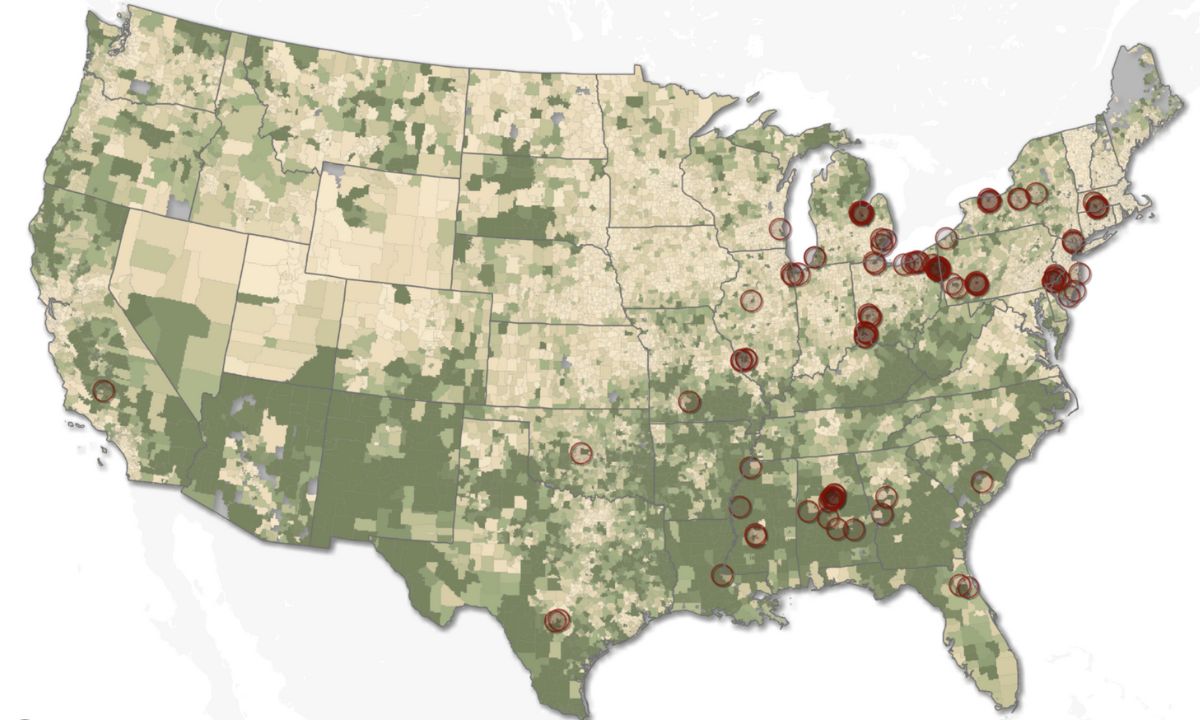Interactive Map: Inside U.S. School Segregation by Race & Class
New America report reveals school district boundaries create divisions that ensure stark inequities.

Get stories like these delivered straight to your inbox. Sign up for The 74 Newsletter
Plopped in the middle of the school district in Dallas, Texas, is an island that has existed unto itself for decades.
Since the mid-20th century, the town of Highland Park has resisted annexation and today operates a separate, roughly 6,700-student school district that is surrounded on all sides by the 139,723-student Dallas Independent School District. Student demographics between the two school systems — and the services they’re able to offer — are markedly different, according to a just-released report from New America’s Education Funding Equity Initiative, which explores how school district borders across the U.S. create racial and economic segregation — often intentionally.
Included in the report is an in-depth, interactive map that allows users to explore school district segregation by race and class in their own communities.
In Dallas, students of color comprise 94% of enrollment and in Highland Park, just 18%. Such segregation extends beyond race. In Highland Park, less than 4% of students live in poverty. In the Dallas school system, a quarter of kids are impoverished, with some of the city’s most underserved neighborhoods just a stone’s throw from Highland Park.
Such jarring school district disparities, which create real-world gaps in learning opportunities for students, exist across the country. America’s patchwork school district borders carry serious consequences for communities and children’s academic outcomes, according to the report by New America, a left-leaning think tank based in Washington, D.C. Nationally, about 30% of school funding is generated by local property taxes, a reality that creates haves and have-nots between property-wealthy districts and those that serve predominantly low-income families.
Much of the disparities can be blamed on inequitable housing policies, such as redlining and exclusionary zoning, which were explicitly implemented to segregate neighborhoods along race and class lines, ultimately showing up “not just in residential patterns but also in school budgets,” said Zahava Stadler, a project director at New America who shared the findings of her research during a workshop last week at the SXSW EDU conference in Austin, Texas.
“These are policy choices that are being made not just in the way we’ve designed school funding systems, but also in the way we actively maintain school funding systems year to year,” she said. “All of those things are policy choices that are being made by state policymakers every single year.”
In total, researchers analyzed more than 13,000 school districts across the country, along with more than 25,000 pairs of neighboring school district borders, to identify how such arbitrary divisions work to generate inequality. Nationwide, they found that, on average, enrollment of students of color fluctuated by 14 percentage points between neighboring school districts. Along the 100 most racially segregated school district borders, however, the average difference was 78 percentage points. In other words, in one school district, students of color comprised 2% of the total enrollment while, in a district directly next door, they accounted for 80% of the student body.
Economic segregation was similarly stark. On average, the enrollment of impoverished students fluctuated by 5.2 percentage points between neighboring school districts. Yet along the 100 most economically segregated school district borders, researchers found the average divide was roughly six times that, at 31 percentage points. One example, the Utica, New York, school district where 33% of students live in poverty, compared to the neighboring New Hartford district where 5% do.
While school district border changes have been used by communities interested in concentrating their affluence, Stadler said the opposite — district consolidation — should be viewed as “a tool in the toolbox of creating more equitable school districts,” establishing schools that are more diverse while ensuring that all students have fairer access to educational resources.
But local context matters. Simply merging school districts to eliminate racial and economic segregation isn’t always the most equitable solution, the report argues, as each area has its own individual policies and contexts. In South Dakota, for example, researchers observed striking racial and economic segregation between the predominantly white Custer School District and the neighboring Oglala Lakota School District, located on the high-poverty Pine Ridge Indian Reservation. Indigenous students represent 96% of enrollment on the reservation and less than 4% in Custer.
An influx of federal and state dollars has left the Oglala Lakota County Schools among South Dakota’s best-funded, but they remain among its lowest-performing. These high levels of funding “do not ensure our children a rich education,” Diana Cournoyer, executive director of the National Indian Education Association, argues in the report. Along with historical challenges and the scars of trauma and colonialism, Cournoyer said, the reservation’s schools also have to contend with bureaucracy and limitations on how they can spend those government dollars. That creates barriers in how they can use funds “to address the unique needs of Native students, which results in inequitable access to opportunities.”
Despite the imbalance in school resources, Cournoyer notes that students on the reservation benefit from cultural and language support — something they could miss if they attended schools in Custer, even with its “nicer facilities and more advanced technology.” The city and its school district were named for George Armstrong Custer, a U.S. commander who fought and killed Indigenous people on the Great Plains before his defeat at Little Bighorn.
“They would not be in a school environment that reflects or values their native culture,” Cournoyer wrote. “They would be isolated, away from the protection of their family and tribal leadership. They would be more likely to encounter racism and stereotyping, making them less comfortable with expressing their Native identity.”
Get stories like these delivered straight to your inbox. Sign up for The 74 Newsletter


